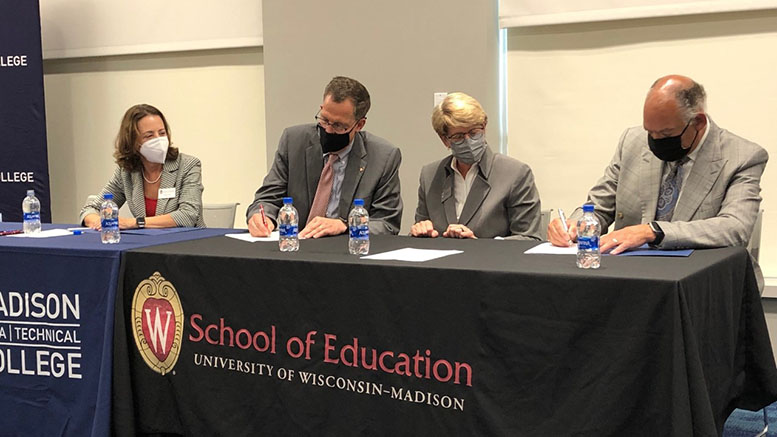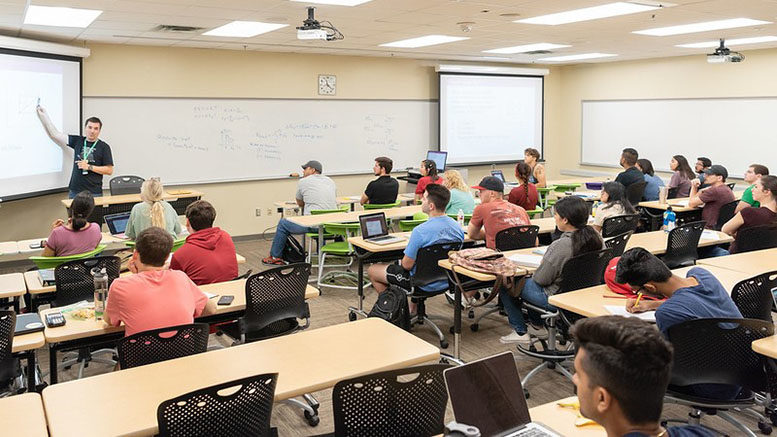The demand for teachers in the United States exceeded the supply by more than 100,000 in 2019 for the first time ever, according to the Washington-based Learning Policy Institute, and that was before the challenges of teaching during a pandemic and resulting burnout.
The U.S. Bureau of Labor Statistics estimated in 2016 that 270,000 primary and secondary teachers would exit the occupation each year through 2026, and the U.S. Education Department offers granular breakdowns of current teacher shortages by state, subject matter and discipline.
Community colleges are gearing up to meet that demand, launching or expanding teacher education programs that provide the first two years of training — or in some cases, all four — along with post-baccalaureate certificate credentials.
Doubling down in Dallas
The Dallas College School of Education started a bachelor’s degree program in 2020 for early childhood educators that enrolls those interested in everything from preschool to middle-school, aimed to help fill the projected 17,770 annual job openings for elementary and middle-school teachers in Texas. The program costs $79 per credit hour, and many school districts in the Dallas area provide starting salaries upward of $50,000, the college notes, which helps to not only expand but also diversify the workforce.
“We saw that there was an opportunity as a community college to raise our hand, say ‘This is a problem in our area,’ and [ask], ‘What role can we play in helping to solve it?’” says Robert DeHaas, vice provost for Dallas College School of Education, a newly created entity since the merger of the seven-college Dallas County Community College District.
DeHaas notes that the district had offered an associate degree in teacher education for a half-century, and that those interested in secondary education still can pursue an associate degree and transfer. The first cohort in the bachelor’s program began in fall 2020 with just under 250 students. The overall School of Education serves about 5,500 students, and DeHaas says the bachelor’s degree program eventually will have about 1,000 students.
In building its program, Dallas College has worked closely with school district partners to determine their individual hiring needs.
“We are not approaching it from the lens of, ‘We want to be a factory producing general teachers,’” he says. “District A’s teacher needs may be different from District B’s teacher needs. We are authentically engaging in a number of conversations with our school district partners to see how we can develop a robust talent strategy to meet their talent needs. That’s really the secret sauce.”
The college is also thinking about students’ trajectories, DeHaas says.
“We’re not just seeing shortages in full-time classroom teachers,” he says. “We’re seeing vacancies across so many different personnel — substitutes, teacher’s assistants, paraprofessionals. What we are doing is saying, ‘Are we able to meet all of those district needs in addition to building the capacity of a future teacher, so they can ultimately become that classroom teacher? How can we kill multiple birds with the same stone?’ … Sometimes it’s going to be out-of-the-box thinking.”
Partnerships with four-year institutions will continue to play a vital role, but the existence of Dallas College’s own bachelor’s degree program has opened the door to new conversations, DeHaas says. Those involve “challenging some preconceived notions, questioning things we’ve done in the past, and rooting it in this idea of having the same collective goal,” he says.
Specifics of these partnerships have included creative ideas like co-enrollment of associate degree students and earlier engagement with advisers and counselors for students planning to transfer, DeHaas says.
“It’s not an us vs. them,” he says. “It is, ‘Hey, we all play an important role in this space, and the more opportunities there are for us to collaborate, [the more] we will provide a more seamless academic experience for our students.’”
New pathways in Madison
In Wisconsin, Madison College signed an agreement with the University of Wisconsin’s (UW) School of Education in September to guarantee admission to aspiring elementary or special education teachers who meet the requirements, including a GPA of at least 3.0.
These students, who can apply to enroll starting in September 2022, also can become eligible for financial support, including in-state tuition and fees, testing and licensing costs, if they promise to work as a preK-12 teacher in the state for three to four years after graduation, through the UW-Madison School of Education Wisconsin Teacher Program.

Wisconsin has faced a teacher shortage for several years that has become worse during the pandemic, as many of those who were thinking about leaving the profession reached an inflection point, says Penny Johnson, professor and coordinator of the education transfer program at Madison College.
“School districts have faced a pinch, with a really dire shortage,” she says.
While Madison College has offered transfer programs for decades, in 2018 for the first time the school began offering the first two years of a four-year education major, a/k/a a pre-major, Johnson says.
“Our transfer students were finding themselves behind, even though they had completed two years of college,” she says. “We really aligned ourselves so that when students transfer, they transfer as a true junior.”
Johnson is pleased with the support from UW-Madison, noting that Madison College hadn’t expected to strike an agreement that led to guaranteed admission.
“We said, ‘We have students transferring to you. What can we do to make it better, and easier and more supportive?’ That question led to this [agreement]. We didn’t know this was going to be the end result.”
In addressing the teacher shortage, as well as diversifying the teacher population, Madison College has created articulation agreements with a number of other four-year schools over the years, Johnson says. UW-Platteville, UW-Whitewater, Edgewood College and Lakeland University are among the most frequent transfer destinations.
“They can transfer anywhere,” she says. “It’s just a matter of working out the details.”
Statewide articulation in North Carolina
In North Carolina, aspiring teacher education students will have a smoother pathway thanks to the August signing of the Comprehensive Articulation Agreement between the North Carolina Community College System and the University of North Carolina System.
Focused on developing a seamless transfer, the Teacher Education/Educator Preparation Pipeline will apply to students in both associate in arts and associate in sciences teacher preparation programs in one of 52 community colleges, who can transfer to one of 15 state universities. Other community colleges are expected to join over time.
At Stanly Community College in Albemarle, that could help address the countywide shortage of teachers, which college administrators estimate is between 50 and 60 — not a high number in an urban area but sizable for small, rural Stanly County.
“Between anecdotal evidence and job listings, we can say there is indeed a teacher shortage in the area,” says John Bowman, head of university transfer program. “That’s one of the needs we want to meet in developing programs recommended by the state.”
Stanly had struck articulation agreements with state universities in the past but hasn’t had one in a while, and the new articulation will provide the opportunity to take a “grow your own” approach that keeps teachers in Stanly County, says Cyndie Osborne, head of the early childhood program, as well as an instructor and advisor. “It’s so they don’t go out to another school and then never come back,” she says.
The teacher preparation degrees were newly developed in the community college system in 2020, and they include 14 hours of education-focused credits in addition to 45 general credit hours, Bowman says.
“That exposes them to the classroom and helps them realize, ‘This is what I want to do,’” he says. Although inroads already had been established prior to those programs, they’ve helped to smooth the journey, he adds.
Stanly also has provided career and college Promise pathways for juniors and seniors in high school to get an early — and free — jump on the teacher preparation pathway, Osborne notes.
“The overall goal is to remove as many barriers as possible and help funnel them forward, so we can address this teacher shortage—and make sure that our teachers represent the communities from which they come,” Bowman adds.
Collaborations in California
California Community Colleges’ teacher preparation programs prepare about 60% of the teachers who graduate from the California State University (CSU) system, and they’re expanding regional collaborations to expand and diversify the workforce. These “communities of practice” with K-12 districts, CSU campuses and the University of California system are working to align and articulate curriculum, develop faculty, disseminate best practices, recruit diverse teacher candidates and widen education pathways.
The needs aren’t just in large metros like Los Angeles, according to Renee Marshall, a consultant who works with teacher preparation programs at several community colleges and serves as an informal statewide lead.
“A lot of our districts that are smaller and off the radar are really struggling, especially when it comes to grow-your-own,” she says. “Nobody has enough staffing right now. It touches all those small communities that are not as flashy. There are certain areas where people go, ‘What am I going to do there? How will my family transition there? How will my spouse find a career?’”
While only a handful of California’s community colleges have had longstanding teacher education programs, more than 90 out of the 116 statewide are now offering some level of training, and the previously accepted conventional wisdom that teacher prep is purely the purview of four-year universities has melted away, Marshall says.
“We’re trying to make sure students have those opportunities embedded throughout,” she says. “We’re also looking at, ‘How do we diversify the field of education?’ At the community college level, we have a great opportunity vis-à-vis our four-year counterparts. … We’re providing a lot of different kinds of on-ramps. How about we get you on an on-ramp to be a paraeducator? Then, if you like this, here’s what you need to do to get a full credential for teaching.”
Teacher retirements have accelerated during the pandemic, and Marshall expects the shortage to worsen in the coming years statewide, especially to whatever extent controversies over mask mandates and toggling back and forth between remote and in-person education continue onward.
“‘Other duties and responsibilities’ has extended so far right now that people are going to be like, ‘This isn’t worth it.’ Compensation doesn’t match duties,” she says. “Right now, we cannot train teachers fast enough.”
The regional collaborations are designed to fill that gap, Marshall says. A recent statewide conference on the topic brought together around 70 community colleges, 15 Cal State campuses, “a good amount of UCs, a lot of preK-12 people,” she says. “The interest for collaboration is absolutely there. The community college system has tried to create space. We’ll continue to open those spaces for conversation.”

